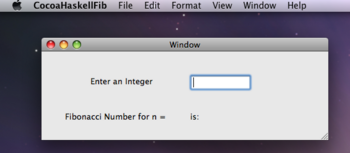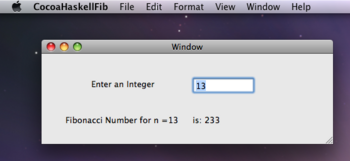User:JRV
Here, we develop a simple (Mac) Xcode project using Cocoa, the Interface Builder (IB). The project follows the Model-View-Control design pattern encouraged by Apple, with the View and Control entirely in Cocoa and IB, and the Model in Haskell.
This is far from fulfilling the request found in the Missing tutorials page. But it is a simple process, not requiring adding any Xcode plugins, or other extra applications.
It assumes you know something about Xcode, and something about Haskell. Its not an objective-c bridge.
Why?
Why would you want to do this? Those with Xcode/Cocoa experience will not need an explanation. On the chance that someone else is browsing here, I'll list a few things.
- Cocoa is not a language, it is a vast library of Objective-C objects.
- Cocoa covers tasks such as:
- windowing,
- displaying tables, outlines, trees,
- text fields (with built in editing),
- pretty easy printing, with pdf automatically available, and
- on and on...
- Objective-C is built on C, and is basically syntactic sugar for C.
Together with Interface Builder, one can define most user interfaces with simple drag and drop from a library of element, then connect them with your code by dragging and drop in the IB screen.
You automatically get full integration with the Mac system. You get the Mac Aqua look.
Enough said. What Cocoa doesn't provide are the tools for mathematical modeling of an application domain that Haskell provides. Parsing comes immediately to mind.
In the interest of full disclosure—I'm not an old time Mac person. I've had my Mac for two years. I only decided to learn Objective-C and Cocoa after I explored doing an application using Python and Qt, and someone in the Python community said “Objective-C is easy. Why don't you write a real Mac application”. Neither am I a Haskell expert. Although I've tinkered with Haskell for a long time (and it is probably my favorite language), I've just come back to it after a couple years away.
Overview
Here are screen shost of the simple application we will develop. The first shows the application widow (together with the menu automatically generated by Xcode), ready to enter a number.
The second shows the same scene after entering a number in the text box, and pressing “return”.
The entire user interface was built in a short time using the graphical Interface Builder, by dragging text the entry box, and the labels from a library of “controls” onto the window. Notice that the labels are dynamic, in the line “Fibonacci Number for n = is: ”.
I won't discuss Interface Builder any further in this tutorial.

